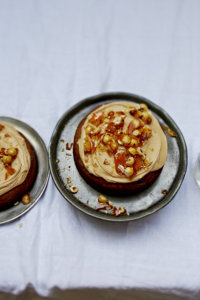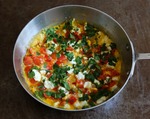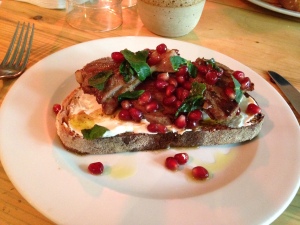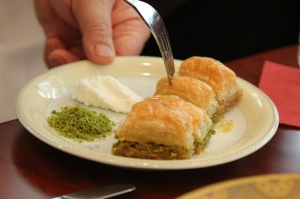Just a week to go to the Kerrygold Ballymaloe Literary Festival of Food and Wine 15th-17th May, there’s a mouthful! Could just be the longest title of a food festival anywhere in Ireland. Things are really hotting up here at Litfest HQ.
The action takes place at Ballymaloe House, the Grain Store, The Big Shed and at the Ballymaloe Cookery School in Shanagarry. Again this year, we’ve got an amazing line up of speakers, workshops and events. The Food and Drinks Theatre has expanded and the Fringe Festival in the Big Shed at Ballymaloe is exploding!  I can scarcely keep up with all the exciting developments. Just keep checking out www.litfest.ie. So here’s a taste of what’s to come.
Alice Waters is coming at last. She had planned to be with us for the inaugural Litfest in 2013 but had to cancel just days before because of a fire at Chez Panisse, her legendery restaurant in Berkeley in California. She’s really excited to be coming to Ballymaloe once again and texted the other day to say she’s counting the days – how sweet is that.
We’ve also managed to entice Christian Puglisi from Relae and Manfreds og Vin in Copenhagen. He’ll share his intriguing story and talk about his new award winning book Relae.
April Bloomfield described as the ‘best woman chef in America’, burst onto the New York food scene with her cooking at The Spotted Pig gastro pub plus John Dory, the Breslin…she’ll be doing a cookery demonstration on Saturday May 16th at 9.30am.
Sarit Packer and Itmar Srulovich of Honey & Co in London are sweethearts, they too are coming over. Their dinner is sold out but they’ll be with us all weekend so you can get your Honey & Co book signed.
Sam and Samantha Clark of Moro and Morita’s dem is also sold out but they are in conversation with Rory O’ Connell in The Grain Store on Sunday May 17th at 2.30pm.
Don’t miss my friend, David Tanis, New York Times food correspondent and chef at Chez Panisse for 25 years. He will read from his book award winning, One Good Dish.
Multi award winning Parisian, author and blogger David Lebovitz  who also came to the New York launch is participating in several sessions.
Lovers of Chinese food won’t want to miss Fushia Dunlop,  described as the best writer in the West on Chinese food, she’ll do a cookery demonstration at the Cookery School on Sunday.
And there’s Allegra McEvedy, Rachel Allen will host her cookery dem at the Ballymaloe Cookery School on Saturday May 16th at 10am.
Jack Monroe is a fresh new voice in food you can also bring your child,  FREE to Jack Monroe’s Parents and Children’s interactive cookery dem at 2pm on Saturday.
We’ve also got an amazing line up of Irish chefs. Kevin Thornton, from Thornton’s restaurant in Dublin, JP McMahon from Cava and Anair in Galway and Leylie Hayes and Hugo Arnold….
Several past Ballymaloe Cookery School students as well as Leylie Hayes will strut their stuff, food historian Dorothy Cashman, Green Saffron, Spice King Arun Kapil and Charlotte Pike who will do a Fermentation workshop to coincide with publication of her new book Fermented Food and Drink. Check out cookbook chronicles with Caroline Hennessy. For budding food writers Regina Sexton will host a UCC Food Writing workshop.
………This year for the first time, Cully and Sully have teamed up with Michael Kelly to create Veg About beside the Big Shed. It’s all about sowing, growing, eating and composting – a celebration of the great food cycle from plot to plate. There will be a Garden Tent where there is Rants, Raves and Ruaille Buaille, Banter with Jim Carroll. Don’t’ miss foraging with legendary Roger Phillips,  Alys Fowler…..
The Litfest fringe in the Big Shed continues to gather momentum. Can you imagine it could be even more happening than last year?
A wide range of local and national artisan food producers, art installations, upcycled furniture by Elemental Design and wonderful artists like Aoife Banville, Yvonne Woods and Sharon Greene.
Camilla Houston will be in the Family Corner, she has organised fantastic interactive, educational and fun activities for children to get involved in.
Sommelier, Colm McCan is the Wine and Drinks Events Manager of the Food and Drink Theatre. Wait, till you see what he has in store natural wines, artisan beer and ciders, spirits and cocktails, you’ll get to see cocktail guru Dave Broom and Nick Strangways, master gin distiller Desmond Payne. One of the top brewmasters Garrett Oliver from America will be here and coffee guru Tim Wendelboe comes all the way from Norway.  He’ll tell you the story of Bean to Cup.
Jancis Robinson MW is back again this year, don’t miss Wines New Wave Lighter and Fresher on Saturday at 2.45 in the Drinks Theatre
Â
Aah, I’m running out of space and there’s SO much more check out the website for events though most events are indoors storm the heavens for good weather.
Â
Hot Tips
Kirsti O’ Kelly of Silver Darlings, based in Co. Limerick. Kirsti pickles herrings using traditional recipes handed down from her mother and grandmother in her native Finland. Kirsti has won several awards for her beetroot and horseradish and Star of the Sea herring. Catch her every Saturday at the Limerick Milk Market.
www.silverdarlings.ie or 086 066 1132
Get Blogging with Lucy Pearce on Saturday May 30th . Join Lucy on a whistle-stop tour of the food blogging world and see what’s hot and what’s not. You will learn the basics of blog design, the secrets behind writing popular posts, how to find and keep readers, where to find technical support and much more. For more info phone the Ballymaloe Cookery School on 021 4646785 or book through the website www.cookingisfun.ie
Don’t miss Jack Monroe’s Parent and Children Interactive Cookery Demonstration at the Ballymaloe Cookery School on Sunday May 17th. Parents are invited to bring along one of the younger members of the household (8-12 years) to attend the demonstration for free and Jack will call on some of the juniors to join her at the demonstration counter for practical cooking fun. See the litfest website (www.litfest.ie) for the details.
Â
Moro Lebanese Spring Vegetable Soup
Serves 4
Crispbread
25 g (1 oz) butter
2 pitta breads
1 litre (13/4 pints) chicken stock
150 g (5 oz) podded young broad beans
150 g (5 oz) shelled peas, fresh or frozen
5 green asparagus spears, woody stems snapped off at the base, cut into 2 cm pieces (keep tips intact)
2 raw globe artichokes, trimmed, cut into quarters and very thinly sliced
1 large bunch of fresh mint, flat leaf parsley, coriander, roughly chopped
2 spring onions, finely chopped
Juice of ½ lemon
Sea salt and black pepper
First make the crisp bread. Preheat the oven to 180°C/350°C/gas 4. Melt the butter, and as it is melting, carefully split the pitta in half lengthways and brush the bread on both sides. Place the pitta halves on a rack in the middle of the oven. Bake for about 10-15 minutes or until golden brown. Remove and cool.
Heat the chicken stock in a large saucepan and check for seasoning. Bring to a gentle simmer and add the broad beans, peas, asparagus and artichokes. Cook for 1-2 minutes until the vegetables are tender. Remove from the heat and add the herbs, spring onion, lemon juice and crisp bread broken into small pieces. Season again and serve hot.
22/4/2015 (18287) Taken from Moro The Cookbook
Honey & Co Prawns in Orange, Tomato and Cardamom
Serves 2
2 tablespoons olive oil
1 orange, thinly sliced
2 tomatoes, thinly sliced
2 garlic cloves, peeled and thinly sliced
2 sprigs of fresh thyme
½ small red chilli, seeds removed and thinly sliced
3 cardamom pods, crushed to reveal the black seeds
12-14 large prawns (about 200 g once peeled)
Sea salt
Freshly ground black pepper
3-5 tablespoons water
Heat the oil in a frying pan over a high heat until it just starts to smoke. Carefully place the orange slices in the oil and cook for 30 seconds, then turn them over with a fork. Add the tomato, garlic, thyme, chilli and cardamom and cook on a high heat until the tomato slices start to break down a little (about 2 minutes). Add the prawns to the pan and season with sea salt and pepper. Cook them for a minute on each side. Add 3 tablespoons of water and cook for a further 2 minutes or until the prawns have turned pink. If the pan is looking dry, add the remaining 2 tablespoons of water, so that you have enough liquid to form a sauce.
Serve immediately with bread to mop up the juices.
22/4/2015 (18288)
Honey & Co Food from the Middle East by Sarit Packer & Itamar Srulovich
Moro Chicken, Tahini Yoghurt and Red Chilli
Serves 4
Chicken Marinade
½ small onion, finely grated
2 garlic cloves, crushed to a paste with 1 teaspoon salt
½ teaspoon smoked sweet Spanish paprika
½ teaspoon ground cinnamon
Juice of 1 lemon
1 tablespoon extra-virgin olive oil
400 g (14 oz) organic chicken fillets (whole) or breasts sliced into 2 cm thick strips
Tahini Yoghurt
3 tablespoons tahini
200 ml (7 fl oz) strained Greek yoghurt
Juice of ½ lemon
2 tablespoons extra virgin olive oil
To Serve
1 tablespoon black onion seeds
1 red chilli, deseeded and chopped
Handful of coriander leaves
1 lemon, cut into quarters
Mix the onion, garlic, spices, lemon juice and oil in a bowl, add the chicken, coat well and refrigerate for 30 minutes or overnight.
The chicken is best charcoal-grilled on a hot barbecue or seared on a griddle pan over a high heat, or under a grill, turning once until just cooked.
To make the tahini yoghurt: put the tahini, yoghurt, lemon juice and olive oil in a bowl, season with salt and pepper and mix well. If the mixture seems too thick, loosen with a splash of water.
Place the chicken on a plate and spoon the tahini yoghurt over the top. Sprinkle with the black onion seeds, chilli and fresh coriander. Serve with the lemon on the side.
22/4/2015 (18289) Taken from Morito by Sam and Sam Clark
Peach Leaf Crème Brûlée
Serves 4 approx.
Crème brûlée the original ultimate custard. Here we flavour it with peach leaves, the latter almond flavour is strangely addictive.
Many leaves impart delicious flavours to syrup, sorbets, ice creams and custard. We use the young leaves from the white peach tree on the front wall of the school dining room for this.
10g (½ oz) peach leaves
2 large egg yolks, free-range and organic
½ tablespoon sugar
300ml (½ pint) double cream
½ vanilla pod (optional)
Â
Caramel Topping:
110g (4ozs) sugar
75ml (3fl ozs) water
125ml (4fl ozs) whipped cream, optional
Make at least 12 hours in advance.
Heat the cream to shivery stage, turn off the heat and add the peach leaves and allow to infuse for 30 minutes. Mix egg yolks with ½ tablespoon of sugar. Pour it slowly onto the yolks, whisking all the time. Return to the saucepan and cook on a medium heat, stirring until it is thick enough to coat the back of a spoon. It must not boil. Remove the vanilla pod, pour into a serving dish and chill overnight. Be careful not to break the skin or the caramel may sink later.
Next day make the caramel.
Dissolve the remaining sugar in 75ml (3fl oz) water. Bring to the boil and cook until it caramelises to a chestnut brown colour. Remove from the heat and immediately spoon a thin layer of caramel over the top of the custard. Alternatively sprinkle the top with a layer of white castor sugar or pale demerara sugar, spray with a film of cold water, then caramelise with a blow torch.
Allow to get cold and pipe a line of whipped cream around the edge to seal the joint where the caramel meets the side of the dish. Serve within 12 hours, or the caramel will melt.
To Serve
Crack the top by knocking sharply with the back of the serving spoon. Alternatively sprinkle the top with a thin layer of castor sugar and caramelise with a blow torch.
Note
2 yolks only just set the cream. Be sure to use big eggs and measure your cream slightly short of the 300ml (½ pint). The cream takes some time to thicken and usually does so just under boiling point. It the custard is not properly set, or if the skin which forms on top while cooking is broken, the caramel will sink to the bottom of the dish. If this problem arises, freeze the pudding for 1-2 hours before spooning on the hot caramel.
Â









